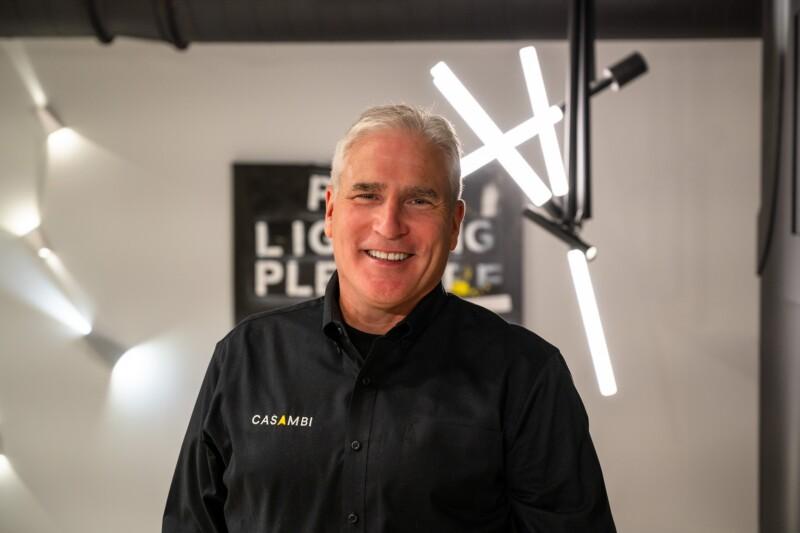Smart Lighting for the City of London

For the City of London’s light pollution reduction strategy to succeed, we need to rethink our control systems. We need lighting with no strings attached.
In alignment with its sustainability targets, the City of London has set forth a proposal to implement sweeping changes in the way the Square Mile is lit at night. The richest patch of land in Britain, the Square Mile – the beating heart of London – is home to the Bank of England, St Paul’s Cathedral, the Gherkin and many high-rise enterprises in between.
Compiled in collaboration with lighting designers, Speirs Major, the proposal suggests the creation of ‘district brightness zones’ with cascading lights-out (or rather… lights-dimmed) policies to reduce the presence of excessive artificial light after dark. Light pollution is a great source of energy waste, known to degrade biodiversity and cause adverse effects on human health.
They’d like to impose three curfews. 22:00 for residential and heritage sites. 23:00 for tourist destinations and 00:00 for commercial, retail and transport locations. From these times, external lighting (bar security lighting) must be turned off or significantly dimmed, and the same goes for interior lights, especially so when buildings sit unoccupied after business hours.
The proposal – which is currently under review before it is formally adopted - also provides guidance for property developers on lighting buildings and their surrounding spaces. It covers the design, delivery, operation, and maintenance of artificial light in the public realm within the City of London. The development and implementation of smart technologies such as motion sensors, time clocks and other automated control devices are recommended in the report.
The City’s challenges.
As a bustling 24/7 business district, how will the City ensure that those who work nightshifts feel safe after lights out? Will such curfews detrimentally impact bars and restaurants that are customarily open until late? Will darkening the Square Mile reduce its charm and historic character? How can such a strategy be introduced during the planning process for any new buildings? How can the City incentivize owners of existing buildings to retrofit the right technology in adherence with these new rules (that are not legally enforceable, by the way)?
This report provides detailed principles that will help to achieve six Lighting Outcomes in the Square Mile:
| Topic | Outcomes |
| A. Sustainability and climate change | – Minimise embodied energy to help reduce carbon emissions. – Minimise operational energy use to help reduce carbon emissions. – Employ circularity through design and specification to help reduce material waste. – Minimise obtrusive light such as sky glow, glare, excessive visual brightness, light spill and light intrusion that adversely impacts biodiversity, particularly within green spaces and adjacent to or within the river. |
| B. Residential amenity | – Minimise obtrusive light that adversely impacts local residents created by permanently installed interior, street, amenity, architectural, and landscape lighting and illuminated signs and media. – Minimise obtrusive light that adversely impacts local residents created by temporary construction lighting. |
| C. Public realm | – Employ lighting to help create an attractive, legible, safe and secure public realm after dark. – Employ lighting to help promote mobility, sustainable travel and support wayfinding, and accessibility. – Employ lighting to help promote culture and the arts. |
| D. Architecture, heritage, and public art | – Employ lighting to enhance and preserve the City of London’s architectural heritage and historic places. – Employ lighting to enhance new architecture, but only where justified. – Employ lighting to enhance public art. |
| E. Safe and inclusive design | – Employ lighting to ensure that public places and buildings are accessible for everyone. – Employ lighting to help promote inclusion and diversity, and create places where everyone feels safe. – Employ lighting to support and promote walking, cycling and the use of public transport. |
| F. Temporary lighting | – Consider the opportunity for the inclusion of infrastructure to support temporary lighting for festivals and events. – Minimise construction lighting to that required to meet safety and security requirements only. |
The document includes what it calls the ‘Considerate Lighting Charter’ which sets out simple yet important steps that everyone can voluntarily take to ensure the: “… right light, in the right place at the right time, controlled by the right system.”
‘By the right system’.
The report says the way in which lighting performs after dark each night will be reliant on the manner in which it is operated and maintained. Under this proposal, applicants will need to submit full details of their intended operational and maintenance requirements for the exterior lighting and any interior lighting. Covering the following:
| Item | Requirement |
| Control Methodology | General summary of anticipated methodology for the control of all external lighting and all internal lighting visible from the public realm. |
| Control System | Details of exterior and interior control systems including general type, control protocol, confirmation of degree to which lighting is dimmable and details of operational interfaces that control the timing of the external lighting and internal lighting visible from the public realm including PIRs, photocells, programmable and astronomic timeclocks. |
| Operational Times | Details of operational timings and approximate lighting levels as a percentage of full brightness for all external lighting and internal lighting visible from the public realm to demonstrate compliance with pre-curfew and post-curfew lighting requirements as stated in this guidance including details of different lighting moods or scenes. |
| Maintenance of Lighting Equipment | General method statement for the maintenance of all lighting equipment providing the external lighting and internal lighting visible from the public realm including intervals for inspection and cleaning of lighting equipment including details of access requirements and timings. |
| Replacement of Lighting Equipment | General statement for the anticipated upgrading and/or replacement of all lighting equipment providing the external lighting and internal lighting visible from the public realm including LED chips, luminaires, accessories and drivers together with details of how such equipment will be recycled or disposed. |
Wireless is the way to go.
Wireless lighting control systems can play a pivotal role in helping applicants achieve compliance. Casambi was borne out of the vision that Bluetooth Low Energy would revolutionize the way we connect with and control lighting. It finally presented us with the opportunity to move on from primitive on/off control to a world of highly customizable experiential lighting.
We offer a lighting control system that provides designers and manufacturers the ability to wirelessly link devices together enabling the creation of smart lighting networks that are configured and controlled using the Casambi App. Casambi allows for instant precision tweaking at the touch of a button. Dim lights, program networks to provide light only when it is useful, adjust color temperature, set circadian profiles, and control motorized blinds. The chipsets we use also offer long-range radio modes to meet the demand for wireless communication within lighting networks installed in vast outdoor spaces. It’s a highly versatile solution for those seeking to restore and protect the natural night environment.
An easy option for retrofit projects.
Casambi is especially great for retrofit projects. Designers charged with upgrading lighting installations in the Big Smoke will want:
Minimal disruption to business: A new design that is fast and easy to install and scale up without the need for surface reconstruction and the pulling of copper wires.
Long lifespan guaranteed: And high performance across the lifecycle of installed lighting products. This is especially important when new lighting designs are taken into use in mission and business-critical spaces too.
Cater to revolving needs: To ensure that different lighting scenarios can be created in the quickest, most cost-effective and energy-efficient way, and that auxiliary lighting can be easily incorporated if/when needed.
Heritage building-friendly: Address the challenge of protecting listed buildings with technology that can be installed with minimal disturbance to conservation efforts and without touching original features.
This requires riffing with tradition.
While DALI is the traditional protocol for lighting control, used alone, it will restrict such ambitious pan-City plans from being realized. Casambi can expand pre-existing wired installations and upgrade them to include a whole host of smart devices for wirelessly networked lighting control.
While DALI is constrained by wires, Casambi offers freedom: How many snaking copper daisy chains of up to 300m with max. 64 addresses per DALI bus are there across the Square Mile? Any extensions or changes to these will require physical wiring adjustments and sometimes architectural reconstruction of a building. With Casambi, full control system functionality comes integrated with a lighting fixture. No wires, no Wi-Fi network, no routers, no extra control devices. Just plug the fixture into the mains and enjoy full control via the app.
While DALI is prone to human error, Casambi is not: Connecting controllers, switches, sensors, modules, and routers to wire takes time, expertise, and money. DALI is harder to test and debug for an on-site electrician, requiring specific deep expertise and experience. No wiring (hence no costly mistakes) is required to set up Casambi. Everything is programmed using software, as many times as desired.
How to get started.
There is a fast track to Casambification. Luminaires with integral drivers, decorative fixtures with LED lamps, or other devices can gain Casambi connectivity using our CBU devices. These are small matchbox-sized units that can be easily installed behind a driver or next to a luminaire with existing IP65 façade lighting. These are really good options for introducing Casambi wireless capabilities to luminaires if you are new to the idea. This option requires zero changes to your setup – just add a module to the device. CBU modules can convert a large multitude of wired luminaires into wireless (1-10V, 0-10V, DALI, Trailing edge dimming…).
Luminaire and component manufacturers with their own electronics R&D design teams develop their own Casambi Ready solutions too. Our CBM module is a chip that’s introduced to the luminaire’s electronics. These are ‘modular radio’ approved for many markets, reducing testing and certification time and costs. And our single-source firmware with over-the-air updates ensures that all installed Casambi Ready devices work seamlessly together, regardless of brand (there are thousands to choose from!).
Wireless, software-based solutions such as ours unleash the full potential of LED lighting. Together, we can offer retrofittable luminaire-level lighting control and customizable lighting experiences that are configurable on the fly and poised to combat the City of London’s light problem, today.
Interested in learning more about Casambi? Drop us a note, and we’ll reach out to you:


